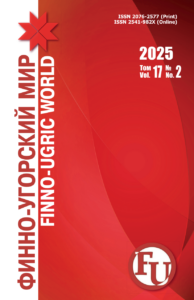Original article
https://doi.org/10.15507/2076-2577.017.2025.01.056-066
EDN: https://elibrary.ru/tbomhf
УДК / UDC 81՚373.231
The Legacy of the Karelian Non-Calenderic Onomasticon in the Toponymy of the Syamozerye Region
A. A. Kongoeva
Petrozavodsk State University, Petrozavodsk, Russian Federation
Abstract
Introduction. In recent decades, scholars in Karelia have been actively conducting research on the toponymy and anthroponymy of the region. The reconstruction of lost Karelian names (both calendrical and non-calendrical) preserved in toponyms holds significant value in the context of cultural heritage preservation, which underscores the relevance of this study. The aim of the research is to analyze the Karelian non-calendrical onomasticon based on the toponymic material from the Syamozerye area, where the Karelian-Livvik population resides.
Materials and Methods. The primary source of material for this research was the data from the scientific toponymic database of the Institute of Language, Literature, and History of the Karelian Research Centre of the Russian Academy of Sciences. In analyzing the etymology of toponyms, dialectal dictionaries of the Karelian language were employed. The preparation of the article utilized both descriptive methods and the method of onomastic etymology, which involves deciphering the origin of a toponym, i.e., identifying the corresponding lexeme of the language that either currently exists or once existed in the studied area.
Results and Discussion. The article analyzes the anthroponymic toponyms of the Syamozerye region, which stem from non-calendar Karelia names. The list comprises approximately 50 anthroponyms, predominantly male names, of which nearly half are zoonymic lexemes. Several anthroponymic toponymic stems with obscure etymologies are presented. The article discusses toponyms reflecting personal names and nicknames that denote negative traits of their bearers, as well as those derived from the names of fauna representatives. In addition to the national anthroponymicon, non-calendar names of Russian origin are also included. The anthroponyms are grouped into several lexical-semantic categories: reflecting external human characteristics; derived from lexemes indicating human qualities, including traits of character and behavior; originating from terms denoting human lifestyles; expressed through fauna-related lexicon. For each anthroponym, toponymic examples are provided along with etymological explanations.
Conclusion. The study of anthroponymy holds significant historical and cultural value. The analysis conducted and its findings will find application in Baltic-Finnish onomastics, including the compilation of toponymic dictionaries and lecture courses on the toponymy of Karelia. The etymology of many Sjamozersk-related anthroponymic toponyms and microtoponyms remains unclear and awaits further investigation in future studies.
Keywords: Karelian language, Livvi-Karelians, anthroponymy, oikonymy, microtoponymy, non-calendar names
Conflict of interest: The author declares no conflict of interest.
For citation: Kongoeva A.A. The Legacy of the Karelian Non-Calenderic Onomasticon in the Toponymy of the Syamozerye Region. Finno-Ugric World. 2025;17(1):56‒66. https://doi.org/10.15507/2076-2577.017.2025.01.056-066
Information about the аuthor:
Anastasia A. Kongoeva, Cand.Sci. (Philol.), Associate Professor of the Department of Baltic-Finnish Philology, Petrozavodsk State University (33 Lenin Avenue, Petrozavodsk 185910, Russian Federation), ORCID: https://orcid.org/0000-0001-5113-5552, SPIN-code: 8624-9308, anastasia20085@mail.ru
Author has read and approved the final manuscript.
Submitted 30.09.2024; revised 25.11.2024; accepted 02.12.2024.























